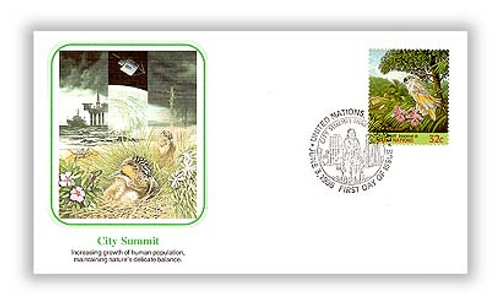
1996 City Summit/Habitat II
# UN678-82 - 1996 City Summit/Habitat II
$6.25
1996 City Summit/Habitat II
UN Offices in New York
UN Offices in New York
City Summit/Habitat II: The worldwide trend toward urbanization has produced a deterioration of living conditions. This problem caused many governments to request a second United Nations Conference on Human Settlements (UNCHS). Also known as Habitat II, the conference was labeled “The City Summit” by the Secretary-General of the U.N., Dr. Boutros Boutros-Ghali. In 1976, the first summit drew attention to problems concerning human settlement. Habitat II was held in Istanbul, Turkey, from June 3-14, 1996. Its goal: making the world’s cities, towns, and villages healthy, safe, equitable, and sustainable.
Over a billion people live with inadequate shelter – meaning without piped water, electricity, roads, or health facilities, and in most cases, security. UNCHS advocates the reform of government policies, institutions, and regulations to enable housing markets to work more efficiently. As one of its methods for improvement, Habitat II encouraged governments to form partnerships with urban dwellers to create city management policies.
People in overcrowded conditions are more likely to lose their homes or be killed during disasters. The poor are also more likely to live closer to waste dumps and other polluted, health-damaging areas. Better planning and regulation of construction can help reduce the effects of pollution and disaster.
Habitat II also focused on women’s issues, as the majority of urban poor are women. Women are more greatly affected by a lack of basic services, since it is traditionally their task to collect water and dispose of refuse. The conference called for recognizing the “informal sector” jobs often filled by women, which include street vending, waste recycling, and food production. Improving job opportunities within this informal sector will allow poor urban women to become more self-reliant.
The stamps commemorating the Habitat II conference were created by Teresa Fasolina of the United States. Recognized as a master illustrator, her work exudes warmth and sensitivity. Best-selling books, magazines, records, and a great deal of advertisements have featured Fasolino’s creations.
Each of the se-tenant strips she created depicts a panoramic view of a city habitat that extends with gradual variations in architecture and foliage – thus transforming the scene of the three designs into a village setting. Each stamp can also be viewed as an independent image. A broad range of cultures and lifestyles are featured on the stamps.
1996 City Summit/Habitat II
UN Offices in New York
UN Offices in New York
City Summit/Habitat II: The worldwide trend toward urbanization has produced a deterioration of living conditions. This problem caused many governments to request a second United Nations Conference on Human Settlements (UNCHS). Also known as Habitat II, the conference was labeled “The City Summit” by the Secretary-General of the U.N., Dr. Boutros Boutros-Ghali. In 1976, the first summit drew attention to problems concerning human settlement. Habitat II was held in Istanbul, Turkey, from June 3-14, 1996. Its goal: making the world’s cities, towns, and villages healthy, safe, equitable, and sustainable.
Over a billion people live with inadequate shelter – meaning without piped water, electricity, roads, or health facilities, and in most cases, security. UNCHS advocates the reform of government policies, institutions, and regulations to enable housing markets to work more efficiently. As one of its methods for improvement, Habitat II encouraged governments to form partnerships with urban dwellers to create city management policies.
People in overcrowded conditions are more likely to lose their homes or be killed during disasters. The poor are also more likely to live closer to waste dumps and other polluted, health-damaging areas. Better planning and regulation of construction can help reduce the effects of pollution and disaster.
Habitat II also focused on women’s issues, as the majority of urban poor are women. Women are more greatly affected by a lack of basic services, since it is traditionally their task to collect water and dispose of refuse. The conference called for recognizing the “informal sector” jobs often filled by women, which include street vending, waste recycling, and food production. Improving job opportunities within this informal sector will allow poor urban women to become more self-reliant.
The stamps commemorating the Habitat II conference were created by Teresa Fasolina of the United States. Recognized as a master illustrator, her work exudes warmth and sensitivity. Best-selling books, magazines, records, and a great deal of advertisements have featured Fasolino’s creations.
Each of the se-tenant strips she created depicts a panoramic view of a city habitat that extends with gradual variations in architecture and foliage – thus transforming the scene of the three designs into a village setting. Each stamp can also be viewed as an independent image. A broad range of cultures and lifestyles are featured on the stamps.










